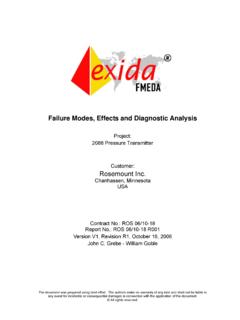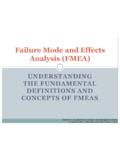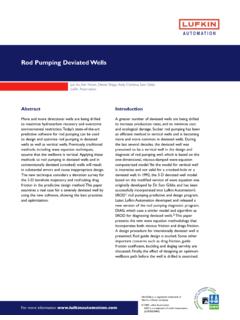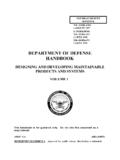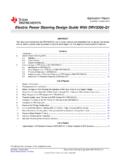Transcription of Appendix 1: Process for Defining SIS Proof Testing ...
1 Appendix 1: Process for Defining SIS Proof Testing Requirements PFD CalculationCan FMbe revealed by direct Testing at PTIMAINTENANCE PHASENOTE 1 YNIdentify failure modes (FMs) of all SIS componentsCan FMbe revealed by other methods at PTI?Redesign SISU pdate PFD calc to show effects of partial testingPFD requirements met?NOTE 2 NOTE 3 NOTE 4 NOTE 7 YNNNOTE 5 For each FM of each SIS componentYPartial Testing Valid optionDESIGNPHASEPFD requirements met?All FMs revealed?Record direct, other or partial test methodNNYYNYNOTE 6 NOTE 8 SRSSIS designFailure dataRepair timesPlant availabilityProof Test IntervalsProof Test Procedures Figure 1: Process for the management of Proof Testing Requirements Notes to Figure 1 Note 1: The SIS design and PFD calculation might be as a result of a new (or modified) SIS or a review of legacy SIS.
2 See guidance below on PFD calculations . Note 2: Refers to credible failure modes that would prevent the SIS operating in accordance with the SRS. See guidance below on Identifying failure modes . It should also include failure modes associated with Diagnostic functions of the components. See guidance below on Diagnostic Functions Note 3: Direct Testing in this case refers to normal Testing typically carried out by instrument technicians at the defined Proof test interval (PTI). See guidance below on Direct Test Methods.
3 Note 4: Other methods in this case refers to any other test completed at the defined Proof test interval (PTI). See guidance below on Other Methods . Note 5: See guidance below on Partial Proof Testing . Note 6: The PFD calculation should be modified to show the effects of partial Proof Testing . See guidance below on Partial Proof Testing . Note 7: The methods identified should be recorded within the Proof Test Procedure. See guidance below on Proof Test Procedures . Note 8: See guidance below on Redesign . PFD Calculations 1.
4 The purpose of a PFD calculation is to show that the SIS has sufficient integrity to reduce the risk of the defined hazards to that assumed within the risk assessment. 2. PFD calculations are normally based upon the undetected dangerous failure rates of the components, the Proof test interval and other parameters such as the mean time to repair (MTTR), etc. 3. Only failures that prevent the SIS from operating in accordance with the safety requirement specification (SRS) should be included within the calculation.
5 4. Sources of failure rate data can be from equipment manufacturers, industry standard data or from site specific failure records. Dutyholders should ensure that the failure data used is applicable to the SIS and associated operating and environmental setting. 5. Good practice BS EN 61511 clause requires that the performance of the SIS is monitored during its lifecycle to ensure that the observed failure rate of components is not higher than that assumed within the design, the PFD calculation.
6 6. If this performance monitoring indicates that component failure rates are higher than assumed, then the SIS might not be providing the necessary risk reduction and therefore it might be necessary to make changes to the SIS or the Proof test interval to remedy this. This could be costly and disruptive. 7. It follows therefore, that the use of more conservative failure data within the design PFD calculation is less likely to require changes later on in the lifecycle. However, it is the responsibility of the dutyholder to select appropriate failure rate data and monitor SIS performance throughout the lifecycle.
7 8. It should also be noted that although a PFD calculation is a quantitative analysis, it is based upon data and assumptions that has potentially significant errors and therefore dutyholders should be mindful of the potential sensitivities within the calculation. 9. failure rates often increase when the components are operated past their expected lifetime. In such cases, the dutyholder should consider replacing the components or taking other measures, such as increasing test frequency, to ensure the overall integrity of the SIS meets that required.
8 Identifying failure Modes 10. Good practice requires that Proof tests reveal undetected dangerous failure modes that prevent the SIS from operating in accordance with the safety requirement specification (SRS). 11. This therefore requires knowledge of the potential failure modes and a clear understanding of the SRS for example if tight shutoff of a valve is required then failure to achieve this would be a failure mode, otherwise it would not be. Equally, response times are part of the SRS and need to be considered as a potential failure mode.
9 12. Some legacy plants may not have a single documented SRS consistent with BS EN 61511 clause 10. However, there should be a description ( within cause and effect diagrams) that, along with other documents and site standards, is sufficient to describe the safety function and allow the failure modes that would prevent the SIS operating in accordance with its design to be determined. 13. It is not necessary to systematically record the failure modes, but the Proof test procedure should record the tests or other methods used to reveal them.
10 14. However, in some cases, for example on larger sites, a dutyholder may optionally choose to record failure modes for different types of components to facilitate generation of consistent Proof test procedures. 15. Identification of failure modes requires expert knowledge, typically held by competent Instrument Engineers and Technicians, and the component manufacturers. The Proof test should include those undetected dangerous failure modes: a. Identified in the component manufacture s documentation.











